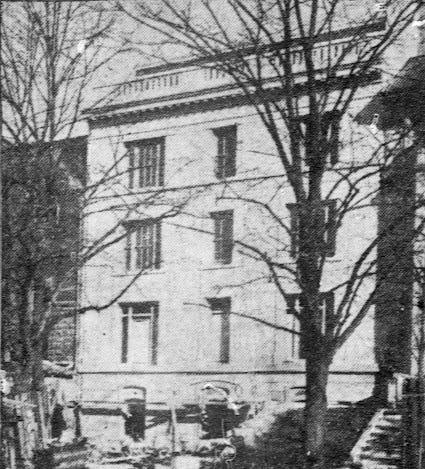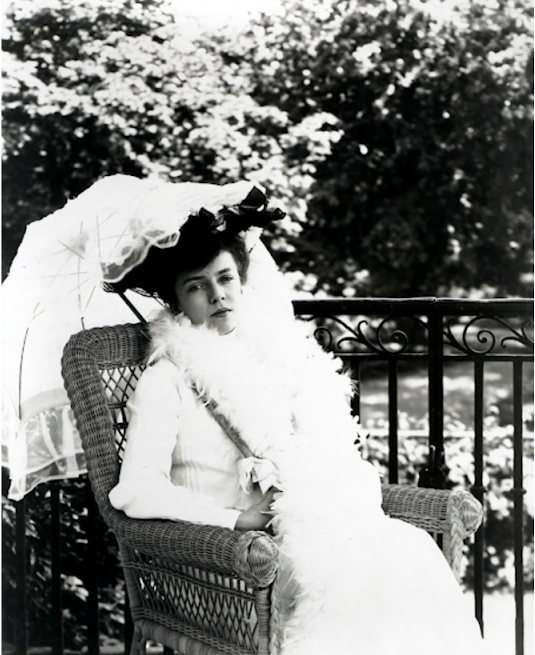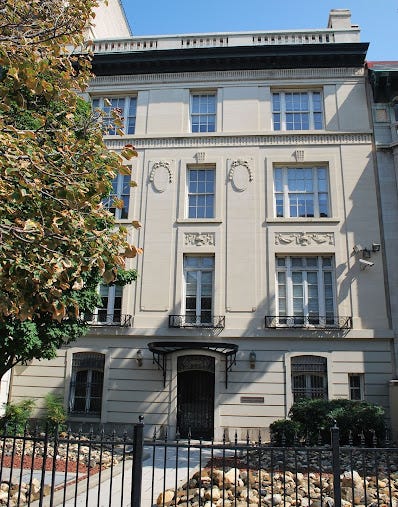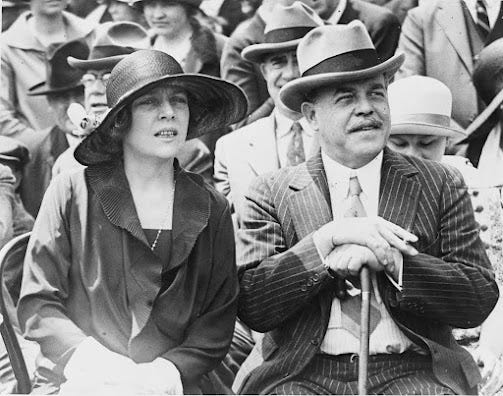"Princess" Alice Roosevelt Longworth
"If you haven't got anything good to say about anybody, come sit next to me." Alice Roosevelt Longworth
The house at 2009 Massachusetts Avenue, now the headquarters of the Washington Legal Foundation, is most associated with its last private resident, Alice Lee Roosevelt Longworth, who lived there from 1925 until her death in 1980 at the age of 96.
Alice was the eldest daughter of President Teddy Roosevelt, a Washington socialite and political power broker, with a keen intellect and an acerbic tongue that could make or break a political career.
2009 Massachusetts Avenue, where Alice Longworth held court for six decades, was built in 1881 for Herschell Main, a native of Sterling, Illinois and a Chief Engineer in the U.S. Navy. It was originally a fourteen room, three-story, red brick house with projecting front and side bays and an English basement. Herschell Main’s father, James Main, regarded as one of the finest mathematicians in the country at the time, also lived at 2009 Massachusetts Avenue and died there in 1894 at the age of 84. After the death of Herschell Main in 1909, his widow Charlotte sold the house and bought the Duddington apartment building at 1754 Lanier Place.
Alice was not the first Roosevelt to live at 2009 Massachusetts Avenue. In 1910, the house was purchased by Robert B. Roosevelt, Jr., a New York banker and stock broker and a cousin to Theodore Roosevelt. Robert was also a cousin once removed to the house’s future owner, Alice Roosevelt Longworth.
Robert Roosevelt, Jr. was the son of Robert Barnwell Roosevelt, a New York financier and a leading of the Democratic National Committee. Before the arrival of his nephew Theodore on the political scene, Robert was the most prominent member of the Roosevelt family. He was a member of the Democratic National Committee and elected as a Democrat to the 42nd Congress from New York's 4th district. But in 1904, he declined to participate in the Democratic National Committee as his nephew Theodore was the Republican presidential candidate, saying that “blood is thicker than water.”
What attracted the younger Robert Roosevelt to the property was probably not the house itself, but its location. Dupont Circle and Massachusetts Avenue had become the area where Washington’s power elite and newly rich industrialists had been building their palaces since the 1880s. By comparison to many of its newer neighbors, 2009 Massachusetts Avenue was a modest and stylistically outdated house.
In 1910, the Beaux-Arts architectural style was the rage in Washington and a fitting architectural statement for both the neighborhood and a man of Roosevelt’s social stature and wealth. Roosevelt expanded the house into an open lot on the east, removed the bays, faced the front with cut limestone, and removed the earthen berm in front to place the street entrance on the basement level. The result was an imposing five-story, limestone house, consisting of 20 rooms and 6 baths.

In 1925, 2009 Massachusetts Avenue was bought by Congressman Nicholas Longworth and his wife Alice Lee Roosevelt Longworth. Alice, born in 1884, was the eldest child of Theodore Roosevelt and during his presidential years, “Princes Alice” as she was known became an instant White House sensation. She smoked cigarettes in public and even on the roof of the White House after her father forbid her to smoke “under” his roof. She rode alone in cars with men, stayed out late partying, kept a pet garter snake named Emily Spinach in her pocket, and was seen placing bets with a bookie. Once asked about his daughter’s exploits, Teddy Roosevelt replied “I can either run the country or I can attend to Alice, but I cannot possibly do both."
Either to capitalize on Alice’s celebrity or simply to get her out of the Washington, President Roosevelt sent Alice on the infamous "Imperial Cruise” on the SS Manchuria, which was the largest diplomatic mission in U.S. history at that time. Members of the mission included then Secretary of War William Howard Taft, 7 senators, 23 congressmen, including Alice's future husband Nicholas Longworth, various other diplomats, and U.S. government officials. True to form, Alice made headlines at every stop of the journey.
In 1906, Alice and wealthy Congressman Nicholas Longworth were married in a White House ceremony. Nicholas Longworth, for whom the Longworth Office Building is named, served as House Majority Leader from 1923 to 1925 and subsequently as Speaker of the United States House of Representatives from 1925 to 1931.
Upon leaving the White House after her father’s second term, Alice is said to have buried a voodoo doll of the new first lady, Nellie Taft, somewhere in the front yard. Her public insults of Mrs. Taft caused her to be banned from the White House. She was also banned from the White House by the Wilsons. An avid isolationist, she was opposed to the US’s entry into the League of Nations and her lobbying at her Washington society dinners and receptions is credited with keeping the United States from joining Wilson’s League of Nations.
Her marriage to Nicholas Longworth was rocky from the start. Although Alice had warned her father against challenging the re-nomination of William Howard Taft in 1912, she publicly supported her father's Bull Moose Party candidacy. Nicholas, on the other hand, stayed loyal to President Taft. During the election season, Alice appeared on stage with her father's vice presidential candidate, Hiram Johnson, in Nicholas Longworth's home district of Cincinnati, Ohio. Nicholas lost the election by about 105 votes, of which Alice jokingly took credit for at least 100 of those votes. However, Longworth was elected again in 1914 and stayed in the House until his death in 1931.
Alice had a long, ongoing affair with Senator William Borah and as a result, was nicknamed “Aurora Borah Alice.” By her own admission, Borah was the father of her daughter, Paulina Longworth. She was born two days after Alice’s 41st birthday in 1925 and was called the “Valentine Baby.”
Longworth publicly opposed her cousin Franklin Delano Roosevelt’s candidacy for the presidency in 1932. She said of him, "He is my father's fourth cousin once removed.... Politically, his branch of the family and ours have always been in different camps, and the same surname is about all we have in common.... I am a Republican.... I am going to vote for Hoover.... If I were not a Republican, I would still vote for Mr. Hoover this time." She once declared that her distant cousin was "one-third sap and two-thirds Eleanor." Eleanor Roosevelt, on the other hand, was her first cousin whom she referred to her as “poor cousin Eleanor” and often imitated her at her tea and dinner parties.
When Nicholas died in 1931, the Longworth family fortune was nearly exhausted. Alice needed to find a way to earn money. In 1933, she published her autobiography Crowded Hours, full of reminiscences of her father, family, and people in public life. With her half-brother, Ted, she co-edited The Desk-Drawer Anthology: Poems for the American People in 1938. She even posed for cold cream and a cigarette advertisements.
Still in need of money, in 1938 Alice put the Massachusetts Avenue house on the market for $50,000, claiming that lecture engagements would keep her away from Washington for a large part of the time during the upcoming years. She planned to keep Washington as her home and move to smaller accommodations. The house never sold and she would remain there until her death in 1980.
As one of Washington most notorious insiders, “Mrs. L” (as she wished to be called) reined over Washington social and political life for six decades from her Massachusetts Avenue home. The political elite sought Alice’s advice and opinions at her famous dinner and tea parties. An invitation to one of her dinner parties was the most coveted invitation in town. She was given the epitaph “the Second Washington Monument.”

Alice developed a close friendship with Richard Nixon when he was vice president. When her daughter Paulina died from an overdose of sleeping pills in 1957, Richard Nixon was a pallbearer at her funeral. After Eisenhower's second term, Alice encouraged Nixon to reenter politics and continued to invite him to her famous dinners.
Although a staunch Republican, Alice became enamored with the Kennedys and befriended Lyndon Johnson as well. During the Kennedy administration, she assisted Jacqueline in restoring the White House. She voted Democratic in 1964, and supported Bobby Kennedy in the 1968 Democratic primary.
When Nixon became president in 1968, he returned Alice’s invitations to her dinners by inviting her to his first formal White House dinner, as well as to the wedding of his daughter Tricia in 1971. Also that year, Nixon threw an 87th birthday party for Alice at the White House. She said of the occasion, “So gruesome. Everyone looks at you and wonders if she’ll last another year.”
Richard Nixon called her "the most interesting conversationalist of the age" and said "no one, no matter how famous, could ever outshine her." Her longstanding friendship with Nixon ended with the Watergate scandal, which she claimed got “boring” after a while. Alice was cordial to Gerald Ford, though in her later years she did not recall ever having met him. Alice ended her association with the White House when Jimmy Carter became president when she declined the opportunity to meet him.
Alice Roosevelt was perhaps best known for her famous quips and quotes, which included “I've always believed in the adage that the secret of eternal youth is arrested development” and “My specialty is detached malevolence.” She stated that her philosophy in life was simply to “fill what’s empty, empty what’s full, and scratch where it itches.” When Senator Joseph McCarthy jokingly remarked at a party “I am going to call you Alice," she responded, "the trash man and the policeman on my block call me Alice, but you may not." She informed President Lyndon B. Johnson that she wore wide-brimmed hats so he couldn't kiss her. When Johnson proudly showed off an abdominal surgery scar, Alice commented dryly, "Thank God it wasn't his prostate." And when a well-known Washington senator was discovered to have been having an affair with a young woman less than half his age, Mrs. Longworth quipped, "You can't make a soufflé rise twice." After a second mastectomy in 1970, she called herself “Washington’s only topless octogenarian.” Perhaps her most famous quote found its way to a needle point pillow on her settee: "If you haven't got anything good to say about anybody, come sit next to me."
In the 1960s and 1970s, when Dupont Circle had become home to hippies, the mansion stood in fading splendor and Alice, the “Duchess of Dupont Circle,” continued to live there, leading a life of shabby gentility. One night during the Vietnam Moratorium disturbances, she stuck her head out of a window during a clash between demonstrators and the police and “got a clear little whiff of tear gas,” which she said “cleared my sinuses.”
Alice never paid much attention to the upkeep of the house and wanted to ensure that guests came to see her and not the house. The front yard was covered with trees, brush and poison ivy (knowing Alice, the poison ivy was intentional). Little light emanated from the windows at night and it looked like no one actually lived there. The house was cluttered with tattered animal skins and stuffed heads from her father’s hunting expeditions, and filled with a lifetime of mementos and photographs. Everything was covered with newspapers and books, with cats crawling all over the house. The kitchen still had the servants’ room bells from more opulent times, now hanging off the walls by their wires. She did not let help spend the night in the house. “I like a day that begins at 11 a.m. after reading all night. They (servants) come at 11, and I say ‘go away’ and then they come back at half past one.” Alice slept on the third floor that had a refrigerator there stocked with late night snacks to accompany her reading.
In her last years, as Alice began showing signs of senility and fewer and fewer friends came to see her. Her granddaughter Joanna, whom she raised after the death of her daughter, would call Alice's friends and urge them to come to visit. In 1979, the year before she died, she opened up the musty mansion for fund-raiser for a yoga center thrown by a distant cousin, Nicholas Roosevelt. Alice stayed upstairs on the third floor with her pet parakeet reading Carl Jung. When informed about the event downstairs, she giggled “They’re doing exercises? Poor simpletons.”
Alice Roosevelt Longworth died a week after her 96th birthday on February 20, 1980. Although Alice was Theodore Roosevelt's firstborn child, she was the last of his children to die, surviving all five of her half-siblings from her father's second marriage. At her own request, her granddaughter buried her without fanfare in Rock Creek Cemetery.








